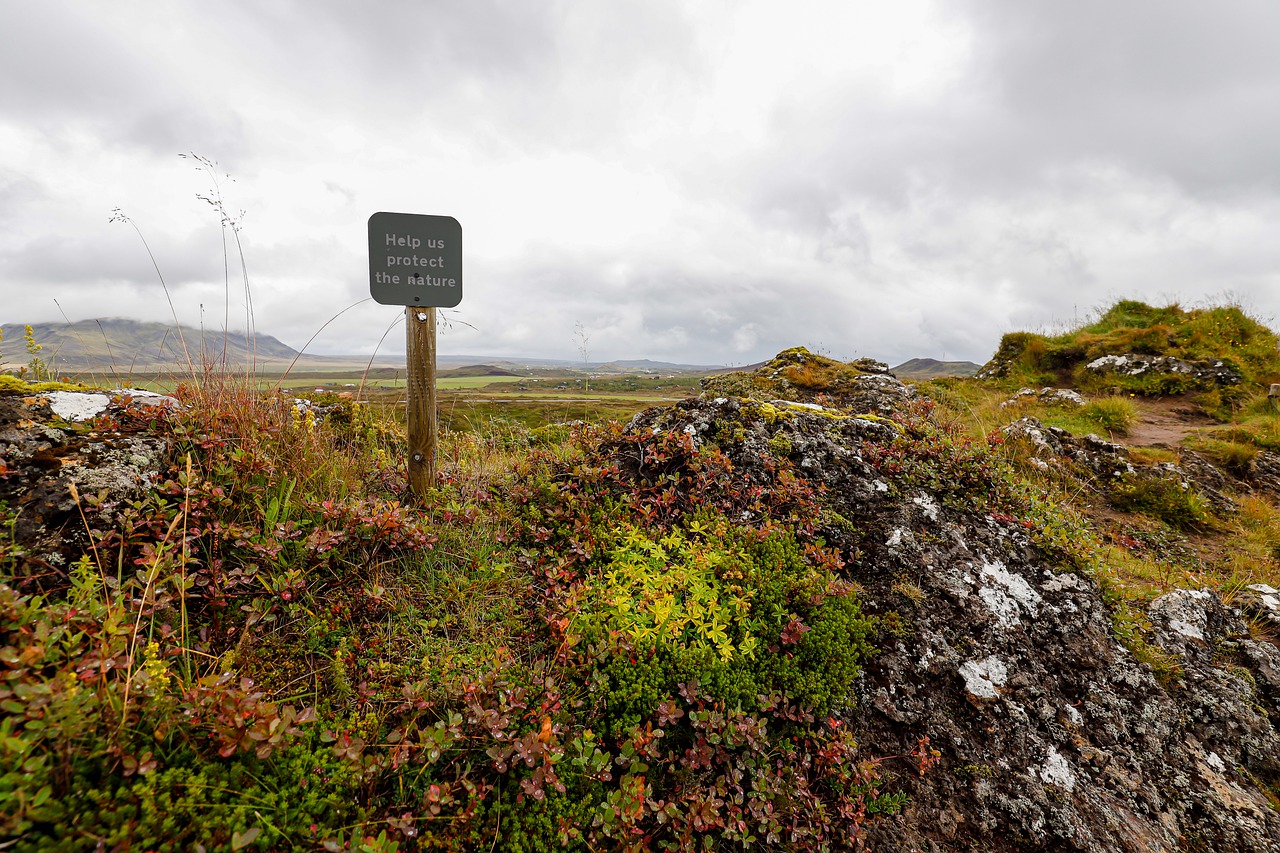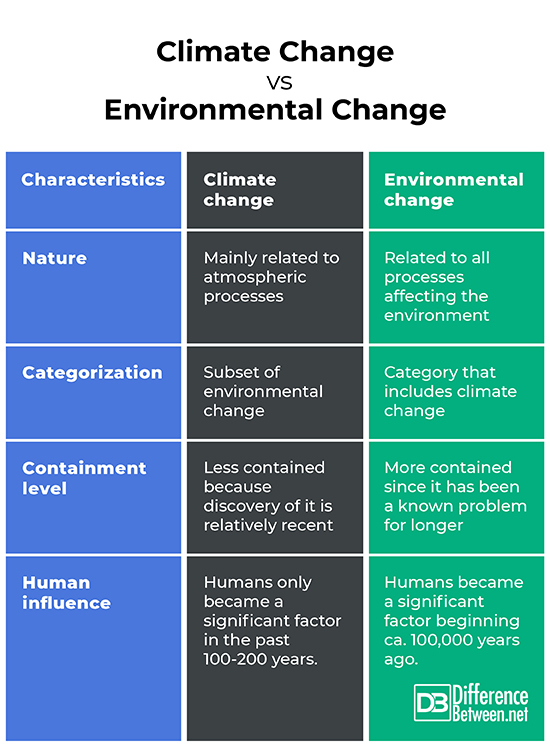Difference Between Climate Change and Environmental Change
What is Climate Change?
Climate change refers to the gradual shift in the climate over time. Climate represents the average atmospheric conditions over a long period of time. This includes temperature, wind, precipitation, and other factors.
Climate change is always occurring, but modern climate change mostly refers to recent increases in temperatures that have been detected since the mid-20th century. The global average temperature has increased by about 1.62 degrees Fahrenheit since the 19th century. This increase in temperature is contributing to the melting of glaciers and ice sheets all over the world and warming of the oceans among other phenomena. Recently, there has also been an increase in extreme weather events which may also be related to this climate change.
What are the Causes of Climate Change?
Climate change is caused by a variety of factors. These factors include changes in atmospheric composition, Milankovitch cycles, and solar activity.
Atmospheric Composition
Certain gases, such as greenhouse gases, play an important role in regulating temperature. Gases such as carbon dioxide and methane, for example, are known for trapping heat in the atmosphere. When the amount of greenhouse gases in the atmosphere changes significantly, this usually results in a change in global temperatures. Phases in Earth’s history where there was an increase in carbon dioxide and other heat-trapping gases also experienced an increase in the global average temperature. A common natural source for carbon dioxide and other greenhouse gases is volcanism. long periods of increased volcanism due to more active plate tectonics have typically been warmer because of an increase in greenhouse gases produced by volcanic eruptions.
In modern times, human civilization produces far more carbon dioxide than geological sources, causing humans to be the primary drivers of the most significant climate change occurring today.
Milankovitch cycles
As Earth and other planets orbit the sun, they go through slight changes of motion and orientation. The three main types of change are precession, changes in obliquity, and changes in orbit shape or eccentricity. Precession involves the change in the orientation of Earth relative to the sun. Obliquity involves the angle of the Earth’s axial tilt. Changes in these factors all have effects on climate. For example, during the northern winter, when the northern hemisphere is tilted away from the sun, Earth is actually closer to the sun in its orbit than it is during the northern summer when the northern hemisphere is tilted towards the sun. This results in slightly more mild northern winters and summers and more intense southern summers and winters. This is because the current shape of Earth’s orbit. At some point, the shape of Earth’s orbit will change so that this is no longer the case. It will be closer during the northern summer and farther during the northern winter resulting in more severe seasons in the northern hemisphere. Also, if Earth had a greater axial tilt, say 30 degrees instead of about 23.5 degrees, the contrast between seasons in both hemispheres would be greater than they are currently. The higher the angle of the axial tilt, or the higher the obliquity, the more intense the difference between seasons becomes. The effects of the Milankovitch cycles are apparent in the geologic record.
Solar activity
Another phenomenon that influences climate is activity of the sun, or solar weather. The sun’s atmosphere produces solar flares which have an influence on space weather. The frequency of these events appears to be connected to a solar sunspot cycle of about 11 years during which the number of sunspots on the sun will grow and shrink regularly. This normal 11-year cycle is occasionally interrupted by a long interim, lasting decades, where there is little or no sunspot activity on the sun. These decade-long periods of low activity are historically associated with cold periods on Earth. A famous example is the Maunder Minimum which began in 1645 and lasted until 1715. During this epoch, there was almost no sunspot activity on the sun. This period was also a time of extreme cold in the already cold Little Ice Age that lasted from 1300 to 1850.
Over the past few years, the sunspot activity has been going down, suggesting we are entering a new solar low period which could last 50 years.
Modern climate change is not best explained by changes in solar activity. This is because, according to recent measurements of solar activity, Earth’s climate should be getting colder not warmer if solar activity is the driving factor in modern climate change.
What is Environmental Change?
Environmental change can refer to a variety of factors that change the natural environment of a locale, region, or planet. Agents of environmental change include atmospheric factors, such as changes in atmospheric temperature, geological factors, such as erosion, weathering, and tectonism, and biological factors, such as the introduction of invasive species.
Geological factors
Geology plays an important role in the environment. The most important geological factors effecting environmental change include volcanism, erosion and weathering.
Volcanism introduces new minerals into the soil as well as gases into the atmosphere. The introduction of minerals nutrients into the soil is one reason why volcanic soils are among the most fertile in the world. Volcanoes can also change the composition of the atmosphere by emitting gases such as carbon dioxide and sulfur.
Plate tectonics causes volcanism. It also creates mountains and valleys. When mountains are formed through tectonic uplifting, this changes the gradient of slopes and can increase the amount of erosion from wind and water. The increase in erosion increases the amount of sediment and the nutrients that enter rivers, valleys, and oceans. This can have a significant effect on the local environment over time. A change in the availability of nutrients from erosion could cause a shift in an ecosystem.
Biological factors
Introduction of new organisms can also cause significant environmental change. This includes invasive species. A famous case would be Christmas island where an introduction of yellow crazy ants has led to the disruption of the local ecosystem and threatens the local crab population. Another example is the introduction of Argentine ants to places all over the world. These ants are becoming major pests and are causing serious problems for the native ant populations that are vital to local ecosystems. Humans have probably been one of the most influential species in modern times in shaping the environment and causing environmental change. Humans are the cause of a growing mass extinction, the reduction in forests worldwide, and the rapid growth of a new biome, cities.
Similarities between Climate Change and Environmental Change
Climate change and environmental change both have a significant effect on life on this planet. They also are both mostly caused by human activity in modern times.
Differences between Climate Change and Environmental Change
Although there are similarities between climate change and environmental change, there are also important differences. These differences include the following.
- Climate change mainly relates to changes in atmospheric conditions, whereas environmental change also involves other factors that don’t necessarily involve atmospheric processes, such as biological and geological factors.
- Climate change is a subset of the category of environmental change.
- Climate change is less contained than environmental change in general since human-induced climate change is a relatively new problem, whereas environmental change has been a problem for a while.
- Humans have only been primary drivers of climate change for about the past century, whereas they have been major drivers of environmental change almost since the dawn of behavioral modernity in Homo sapiens.
Climate Change vs. Environmental Change
Summary of Climate Change vs. Environmental Change
Climate change refers to changes in the regular atmospheric processes in a region. Climate change is primarily influenced by changes in atmospheric composition, Milankovitch cycles, and changes in solar activity. Modern climate change involves a rise in the global average temperature due to the increase in greenhouse gases in the atmosphere over the past few hundred years because of industrialization. It has resulted in melting of glaciers, warming of the ocean, and an increase in extreme weather events among other effects. Environmental change refers to a shifting in natural conditions in locales, regions, or the entire planet. The drivers of environmental change include atmospheric factors, such as change in atmospheric temperature, geological factors, such as volcanism, erosion, and weathering, and biological factors, such as invasive species. Climate change and environmental change are similar in that they both are significant for life on the planet and they both are mostly human caused in the modern period. They differ, however, in that climate change primarily involves atmospheric processes, whereas environmental change involves all processes that shape the environment. Climate change also could be considered a subcategory of environmental change. Furthermore, environmental change is more contained because there are forms of environmental change that humans have mitigated, such as ozone depletion, whereas anthropogenic climate change is a new problem that is yet to be mitigated. Also, humans have only been a significant cause of climate change for the past 100-200 years, whereas humans have been major drivers of environmental change since the rise of behaviorally modern Homo sapiens some 100,000 years ago.
- Difference Between Environmental Performance Index and Development - November 24, 2023
- Difference Between Environmental Intervention and Development - November 8, 2023
- Difference Between Eco Efficiency and Eco Effectiveness - September 18, 2023
Search DifferenceBetween.net :
Leave a Response
References :
[0]Bittel, Jason. “The Christmas Crab Massacre.” Pacific Standard. 14 June 2017. https://psmag.com/environment/the-christmas-crab-massacre. Accessed 28 January 2020.
[1]Ceballos, G., Ehrlich, P. R., & Dirzo, R. (2017). Biological annihilation via the ongoing sixth mass extinction signaled by vertebrate population losses and declines. Proceedings of the national academy of sciences, 114(30), E6089-E6096. https://www.pnas.org/content/114/30/E6089. Accessed 28 January 2020
[2]Campisano, Christopher J. “Milankovitch Cycles, Paleoclimatic Change, and Hominin Evolution.” Knowledge Project, https://www.nature.com/scitable/knowledge/library/milankovitch-cycles-paleoclimatic-change-and-hominin-evolution-68244581/. Accessed 27 January 2020.
[3]“Climate Change: How Do We Know?” NASA.gov, N.D., https://climate.nasa.gov/evidence/. Derouin, Sarah. “Deforestation: Facts, Causes & Effects.” Live Science. 6 November 2019. https://www.livescience.com/27692-deforestation.html. Accessed 28 January 2020.
[4]EarthTalk. “Are Volcanoes or Humans Harder on the Atmosphere?” Scientific American. 11 February 2009. https://www.scientificamerican.com/article/earthtalks-volcanoes-or-humans/. Accessed 23 January 2020.
[5]“Environmental Change.” Cornell University Department of Ecology and Evolutionary Biology, N.D., https://ecologyandevolution.cornell.edu/environmental-change-biodiversity. “Global environmental change.” World Health Organization, N.D., https://www.who.int/globalchange/environment/en/. Accessed 23 January 2020.
[6]Pincetl, S. (2015). Cities as novel biomes: recognizing urban ecosystem services as anthropogenic. Frontiers in Ecology and Evolution, 3, 140. https://www.ioes.ucla.edu/publication/cities-novel-biomes-recognizing-urban-ecosystem-services-anthropogenic/. Accessed 28 January 2020.
[7]Rowles, Alexei D., and Dennis J. O’Dowd. "Interference competition by Argentine ants displaces native ants: implications for biotic resistance to invasion." Biological invasions 9.1 (2007): 73-85. https://link.springer.com/article/10.1007/s10530-006-9009-5. Accessed 28 January 2020.
[8]Staughton, John. “Why Is Volcanic Soil So Fertile?” Science ABC, https://www.scienceabc.com/nature/why-is-volcanic-soil-so-fertile.html. Accessed 27 January 2020.
[9]Weisberger, Mindy. “Global Warming vs. Solar Cooling: The Showdown Begins in 2020.” Live Science, 9 February 2018, https://www.livescience.com/61716-sun-cooling-global-warming.html. Accessed 28 January 2020.
[10]Image credit: https://cdn.pixabay.com/photo/2020/01/07/17/35/environmental-protection-4748209_1280.jpg
[11]Image credit: https://cdn.pixabay.com/photo/2017/02/13/17/37/climate-change-2063240_1280.jpg



